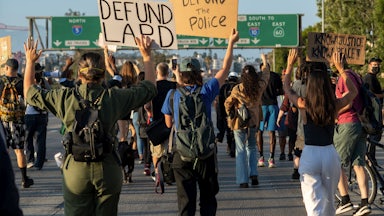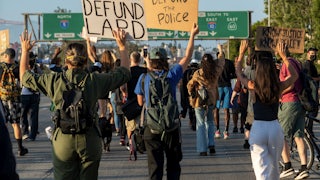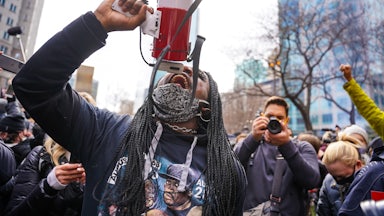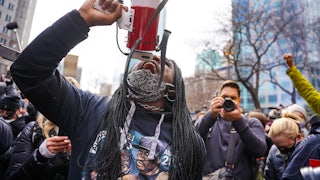When Mary Moriarty thinks about police reform, she always comes back to the lieutenant she met at a training session a few years ago. As Hennepin County’s chief public defender, Moriarty had been watching the Minneapolis Police Department’s work up close for three decades and was intimately familiar with its long history of racism and unaccountable violence. But the new police chief, brought in after yet another shooting of an unarmed civilian, was trying to turn things around and had allowed Moriarty to sit in on one of the department’s implicit bias trainings.
“It was me and about 20 cops, on a Saturday,” Moriarty said. “And there was this lieutenant at my table, and before the thing even started, he said, ‘This is a fucking waste of my fucking time.’” When the training began, they asked people about their goals for the next year. “This lieutenant stood up and said, ‘I want to maintain the warrior mentality, because that’s why I became a cop.’ And it’s like this lightbulb went off in my head, like: Wow, these are the people in supervisory positions, the people who are training new officers, telling them what to do on the street.”
Moriarty thought of the lieutenant again when it was learned that Derek Chauvin, the former police officer who was recorded killing George Floyd last May, had been entrusted with field-training new officers, despite his own lengthy and disconcerting record of abuse. And she thought again of the deeply ingrained police culture shortly before Chauvin’s murder trial, when an anonymous prospective juror, who had lived in the neighborhood where Floyd was killed, described to the court how after someone in the area was killed or sent to jail, police would often cruise down the blocks, blaring “Another One Bites the Dust” through the neighborhood.
“It just really drove home that you can undertake all this training and institute all these new requirements, but it doesn’t necessarily touch the culture inside the department,” she said. “And if we’re ever going to change the culture of the police, that’s going to take years.”
On April 21, the day after a Minneapolis jury found Chauvin guilty of Floyd’s murder, Attorney General Merrick Garland announced that the Justice Department was opening an investigation into the Minneapolis Police Department, examining whether it has a “pattern or practice” of unconstitutional and unlawful use of force and discriminatory policing. The announcement was hailed by many police reformers as a welcome reversal of the Trump administration policy, which had effectively abandoned oversight of local police departments. But as the Justice Department steps back into its role as the ultimate guardian against unconstitutional policing, questions remain about its capacity to drive lasting reforms in local departments. And as the crown jewel of the federal government’s efforts to prevent police from taking people’s lives and rights, some wonder what such a program is worth in a country where police seemingly continue to do just that at an incomprehensible pace. With many who took to the streets last summer skeptical that police can be reformed at all, how the Justice Department approaches the problem of the MPD will likely have implications well beyond the city.
The federal government’s sweeping power to intervene in local police departments is still relatively new. Prior to 1994, the legal avenues available for compelling police forces to consistently respect citizens’ rights were limited. Individuals could sue over unconstitutional police behavior, but courts often found that they lacked standing to seek injunctive relief, and early efforts by the Justice Department to bring civil rights lawsuits against police departments were also shot down in court for lack of standing.
The resulting vacuum of police accountability was brought into sharp relief in 1991, when the beating of Rodney King by Los Angeles police officers, caught on video tape, showed a shocked public how bad a police department can get when no one is empowered to force it to change. The result was a piece of legislation, little remarked upon at the time, tucked into the 1994 crime bill: 42 U.S.C. § 14141. The measure explicitly empowered the attorney general to bring “structural reform litigation” against police departments, suing them to force them to adopt systemic changes to their policies and procedures.
The Justice Department first made use of its new power in a 1996 investigation into the Pittsburgh Police Bureau. As would become the practice with these actions, the department used the threat of a lawsuit to force the city of Pittsburgh and its police into a court-monitored consent decree in 1997, under which the police agreed to undertake a host of reforms.
“The investigation leads to a findings letter, which lays out all of the problems with the local department that the Justice Department found, and then it goes to negotiation,” said Sam Walker, a scholar of police accountability, explaining the procedure that structural reform litigation generally follows. “It’s the equivalent of a plea bargain in a criminal case. The local department is considering how badly things could go if they take the case to trial, and with very few exceptions, they end up deciding it’s better to strike a deal.”
Once the feds and the local police have agreed on a list of reforms the police will undertake, the agreement is approved as a consent decree by a district judge, who appoints a monitor to oversee the department’s reforms. The monitor issues periodic reports—addressed to the court but available to the public—assessing the department’s progress. In addition to new training, federal monitoring relies heavily on the generation of data. Departments that never recorded the race of the people their officers stop, or the frequency with which each officer uses different types of force, find themselves required to do so and, where those numbers are bad, to improve them. If the monitor deems the department to be in substantial compliance with the agreed-upon reforms after a fixed period of monitorship (consent decrees generally keep the monitor in place for five to seven years and are sometimes extended if a department requires more time to come into compliance), the monitor packs up and goes home and the federal oversight is effectively ended.
In a vast country where policing is decentralized, using federal pattern-and-practice lawsuits can look inadequate to the task. In the nearly 30 years since Section 14141 was passed into law, the Justice Department has initiated roughly 70 investigations, of which 40 have resulted in some sort of federal oversight. With nearly 18,000 state and local law enforcement departments around the country, Justice Department investigations feel like whack-a-mole. Defenders argue that even if it’s not sufficient on its own, the threat, however remote, that a police department that habitually disregards people’s constitutional rights might find itself under a very costly consent decree still acts as a useful deterrent.
For those few, high profile departments that do find themselves under federal oversight, legal scholars and police reform experts generally agree that, under the right conditions, consent decrees can be effective at making police departments adopt new policies and structures of accountability for the duration of the monitorship. But very little evidence exists to describe what happens after the departments are out from under the federal thumb, and some of the evidence that does exist suggests that departments tend to return to old habits.
“In a world of imperfect options for addressing police misconduct, structural reform litigation is arguably one of the best things that we have to address the systemic problems of police misconduct,” said Stephen Rushin, an associate law professor at Loyola University who studies federal consent decrees. “Every regulatory mechanism has its shortcomings, and this is no exception. But what it really does better than anything else, is that it takes a package of reforms that we know will, at minimum, improve policing in the community, and it forces that locality to adopt and prioritize those reforms.”
There are any number of factors that can prevent police departments from reforming themselves, Rushin said. Instituting new training and accountability protocols can be expensive, and cash-strapped municipal governments may consider other priorities more important. Reforms can also be costly in terms of political capital, with police unions and other law and order constituencies fundamentally opposed to meaningful changes.
“Once you have a consent decree, it changes all of those conditions on the ground,” Rushin said. “It forces localities to take police reform and investment and accountability and oversight seriously. It forces them to prioritize those investments over other investments. It forces them to make what are often politically unpopular changes, things that may otherwise be stifled through the ordinary political process.”
That’s basically what happened in Pittsburgh, the first city to undergo this new program of federal oversight. After years during which police unions, the department itself, and elected leadership all resisted reform, the federal consent decree forced all the parties to take it seriously. Early indications during and shortly after the monitorship suggested that the reforms had stuck, even if rank-and-file officers were resentful and skeptical of their utility. “Overwhelmingly, the comments of both officers and supervisors about the decree were negative,” concluded researchers who interviewed Pittsburgh officers in 2002 for the Vera Institute of Justice. “Officers took the decree as a slap in the face.” Many credited police Chief Robert McNeilly’s commitment to the reform process with any improvements made.
But McNeilly was forced out in 2006 after ongoing battles with a new mayor more closely aligned with police unions resistant to the reforms. In the six years following McNeilly’s ouster, the department’s use-of-force incidents jumped 38 percent, while civilian complaints against officers jumped 48 percent. By 2013, the freshly resigned Pittsburgh police chief was indicted on federal corruption charges, and a year later the mayor was conceding that things in the department had deteriorated to the point that it could soon face a second federal consent decree.
Pittsburgh isn’t the only cautionary tale illustrating the limited impact of this kind of oversight. In the Maricopa County Sheriff’s Office in Arizona, the Alamance County Sheriff’s Office in North Carolina, and the Albuquerque Police Department, local officials have found ways to slow-walk, subvert, and otherwise stymie the federally mandated reform process.
Reports from other cities put under consent decrees, like Cincinnati and Washington D.C., offer some encouragement that, with cooperative local leadership, Justice Department intervention can produce beneficial changes to a police department that persist even after the federal oversight is lifted.
But the evidence on whether federal intervention can make a bad police department stop violating people’s rights in the long run is pretty much all anecdotal. Part of the problem is that while federal monitors generate enormous amounts of data that can be analyzed for signs of progress or regression, once the monitor leaves, that data often dries up.
“The simple truth is, we don’t know all that much,” said Joshua Chanin, an associate professor at San Diego State’s School of Public Affairs, who studies police oversight strategies. “There’s some research suggesting that this process can help departments make meaningful structural changes, to their internal accountability process, for instance. But what we don’t have a lot of evidence of is how that translates into meaningful, durable policy change and how effectively it leads officers to change their behavior, particularly after the DOJ and the monitor [have] left town.”
Further, Chanin says, it’s one thing to get departments to agree to specific adjustments but quite another to produce deep change. “The DOJ has been really effective at manifesting the specific changes articulated in the consent decrees,” Chanin said. “But what they have been less effective at doing—and what’s difficult about police reform generally—is getting buy-in from the affected departments and the political principals that oversee these departments. You can lay out the tasks, show them the new protocols, the new boxes they have to tick, but that’s not the same as changing the culture. You can’t institute a new culture from the top down, by fiat. It has to sort of populate organically.”
When structures of accountability change but the culture doesn’t, Chanin said, the results can be lackluster and the problems hard to ferret out. This dynamic can be observed with efforts to remove racial bias from traffic stops. “Often the terms of the consent decree will mandate officers to track who they stop, the race, the gender, the purpose of the stop, and the outcome,” he said. “And what you see in my research in San Diego and elsewhere is that faced with that, the officers making the stop just fudge the paperwork. They justify this by saying, ‘You know, I’m not a racist. And if I stopped three Black guys in a row, then all of a sudden, the fourth one appears like a pattern, and I feel like someone else is gonna call me or my boss is racist. And so I either don’t fill out the card, or I say it was hard to tell what the guy’s race was.’”
This kind of slippery compliance with new reporting regimes frequently shows up with body-worn cameras, Chanin said, as officers may turn the cameras off and on at their own discretion. “Compliance with the rule is a function of a lot of things,” he said. “Just by mandating that they do something does not mean that it will result in them doing it. Or maybe they will comply in the short term, run out the clock, and once the monitor is gone, it’s like, ‘OK, we can breathe again.’”
That’s not to say that Chanin sees no value in federal pattern-and-practice oversight. “It is really valuable symbolically,” he said. “It sends a strong message to departments that if you are loose with compliance with constitutional law, there could be a consent decree in your future. I don’t think it’s a silver bullet. Departments don’t automatically go from being the worst in the country to the best in the country in the period of DOJ oversight.”
After languishing for the past four years under Donald Trump, how the Justice Department develops its intervention in Minneapolis could set the template for what a new generation of federal pattern-and-practice litigation looks like.
In Minneapolis, the situation into which the Justice Department is inserting itself is especially complicated. The MPD is a hornet’s nest of overlapping power struggles, with a reform-minded chief, a powerful police union, abolitionists, accountability activists, victims of rising gun violence, the mayor, the City Council, business interests, state human rights authorities, and legislators all battling to define the scope of the problem, what if anything is to be done about it, and who is responsible.
The federal intervention will also be taking place against the backdrop of a nation recently convulsed by the largest rolling protests in its history and a newly prominent, though not ascendant, abolitionist movement that sees policing not as an institution to be reformed and perfected but as an unredeemable tool of oppression to be defunded, diminished, and dismantled. Black Visions, a four-year-old Minneapolis organization born of the Black Lives Matter movement and organizing to defund the MPD, was flooded with $30 million in donations in the wake of George Floyd’s murder and was central to the pressure campaign that led City Council members last year to commit to “begin the process of ending” the police department.
That council members’ seemingly historic commitment quickly frayed into squabbles and backpedaling, but Black Visions and its allies launched a charter-revision petition drive, collecting more than 20,000 signatures in support of a program to replace the police with a new Department of Community Safety. The signatures were validated by the charter review committee, and the language of the initiative is now being reviewed by the city attorney’s office, but it is likely that Minneapolis residents will vote on the proposed amendment in November.
“It’s a really interesting and open question of how the DOJ will see its role here,” says Michelle Phelps, an associate professor at the University of Minnesota who studies police and criminal justice reform. “Will the consent decree encourage some of this radical rethinking, like, for instance, say the city ought to have unarmed traffic enforcement vehicles responding to traffic issues? That would be a real shift from what we’ve seen in the past and the DOJ investigations. More expected from what we’ve seen in the past would be if the DOJ report actually blocked that transformational change by saying the department needs these resources because the work of reform is expensive.”
All this raises the prospect of a philosophical train collision in Minneapolis: What if residents vote forward a grassroots initiative to radically diminish the role and budget of their police, only to see the Justice Department push through a consent decree that calls for a police budget increase to cover the cost of implementing more technocratic, procedural reforms?
“That’s a very real possibility, and it’s something we’re worried about,” said Kennedy-Ezra Kastle, a spokesperson for the Black Visions Collective. “We absolutely are not looking to the Justice Department to liberate the Black people of this city. Their involvement is not going to help our struggle. The police investigating the police? We fully expect them to protect each other like they always have.”
Others see more room for the Justice Department’s involvement to be complementary.
“There’s no question that the Justice Department’s Civil Rights Division is pathologically moderate,” said Christy Lopez, who helped steer the DOJ’s interventions in New Orleans, Newark, Chicago, and Ferguson, and is now a professor at Georgetown Law School. “And yes, if it’s handled wrong, it could just be bureaucratic tinkering with a flawed system. That’s why Minneapolis is going to be a real test for DOJ: Does it just come in and do the same sort of old-school approach to reform? Or does it learn from what it has been doing and what we’ve learned more broadly in this country about what it really takes to change policing?”
Key to a successful federal intervention, Lopez says, will be humility. Coming out of her investigation in Ferguson, Lopez said, “a penny finally dropped for me, and I realized that consent decrees are not going to fix this alone, because so much of policing isn’t about public safety at all. In Ferguson it was about revenue generation. But more generally, it’s about using police to control a racialized social order. So whether the police are acting lawful is part of the issue, but it goes way beyond police.”
The Justice Department should work to support local accountability with its consent decree and should be honest about the limitations of what a consent decree can accomplish without broader changes. “They need to make it clear in their findings report and in a consent decree that this can’t just be about making police behavior conform to the law, there’s also a lot of work that needs to be done in terms of changing how we respond to homelessness, changing how we respond to drug addiction, domestic violence, gun violence, all of these things that cannot just be addressed through a consent decree. That acknowledgment will be key, especially because it will keep local leaders from saying, ‘Well, we did what the DOJ said, we don’t have to do anything else.’”








